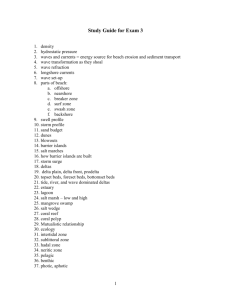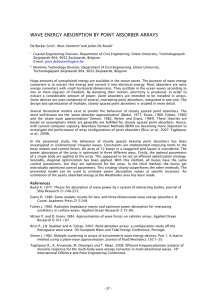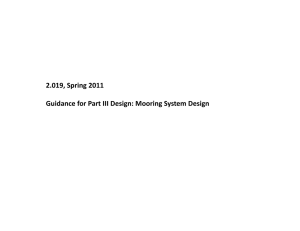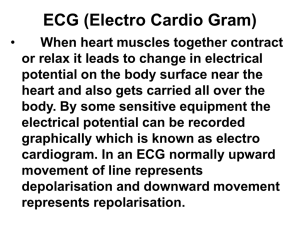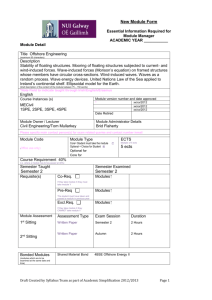wave-energy - University of Otago
advertisement
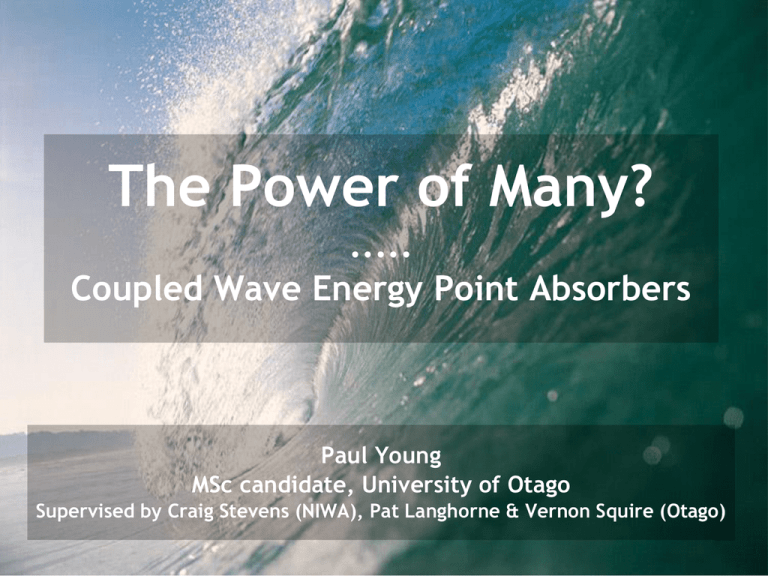
The Power of Many?
.....
Coupled Wave Energy Point Absorbers
Paul Young
MSc candidate, University of Otago
Supervised by Craig Stevens (NIWA), Pat Langhorne & Vernon Squire (Otago)
Talk outline
Motivation
WECs… WTF?
The big idea
The physics
Results
Where to next?
World resource
Wave energy flux magnitude (kW per metre of wavefront)
Source: Pelamis Wave Power website
Source: Smith et al (NIWA), Analysis for Marine Renewable Energy: Wave Energy, 2008
Source: Smith et al (NIWA), Analysis for Marine Renewable Energy: Wave Energy, 2008
• Practical worldwide resource
~ 2000-4000 TWh/year1
• (Current global demand
~ 17000 TWh/year)
Advantages:
High energy density
Low social & environmental impact (?)
Reliability & predictability (c.f. wind)
Low EROEI (?)
Direct desalination
AND...
1. Estimate by UK Carbon Trust
Talk outline
Motivation
The big idea
The physics
Results
Where to next?
Point absorbers
Pros:
Cons:
Suitable for community scale
Less disruption in event of
device failure
Non-resonant in typical
sea conditions
Lower efficiency
Cheaper per kW/h?
Maybe a linked chain of point absorbers
will 'see' long wavelengths better
than a lone device?
Key questions
Is it possible to obtain better power output (per unit)
with a linked chain?
(Can we improve peak efficiency and/or widen bandwidth?)
How are the mooring forces affected?
(Survivability)
What is the interplay between the device spacing and
the wavelength?
My scheme: model device
1-D (surge only) idealisation
Talk outline
Motivation
The big idea
The physics
Results
Where to next?
Further assumptions/simplifications
Small-body approximation
Linear, small amplitude waves
Neglect hydrodynamic interaction between
devices
Forces
Mooring forces
Hydrodynamic forces: excitation,
drag and radiation
Master equation:
maK FM K FE K FD K FR K
(not including power take-off)
Technical issues…
Importance of memory effects
Talk outline
Motivation
The big idea
The physics
Results
Where to next?
Validating numerical code
For lone device with zero drag, easy to solve equation of motion
analytically.
Discrepancy between models with and without memory effects
noticeable when nonlinear drag introduced, but small.
HOT OFF THE PRESS:
Things get interesting with
multiple devices.
Some good agreement...
...some poor agreement...
Talk outline
Motivation
The big idea
The physics
Results
Where to next?
Mooring and linkage forces
Chacterise as tension-only spring
Spring stiffness
FM
J ,K
=
(Linkage force on device J
from device K)
{
Device spacing
− S x J − x K , ∣x J − x K∣ d
0,
∣x J − x K∣ d
Position of device K
Hydrodynamic forces
(The tricky part...)
Inline force on small(ish) bodies in oscillatory
flow often described by Morison equation:
Submerged
volume
Drag
coefficient
Fluid velocity
1
F = V s u˙ ma u−
C d A∣x˙ − u∣ x˙ − u
˙ x¨ −
2
Area 'seen'
Fluid density
by fluid
Added mass
BUT added mass depends on the
oscillation frequency...
For device with a ≈ 2m, energy-bearing wavelengths in typical
sea state are 0.056 ka 0.126
Semi-submerged sphere moving in surge
But under nonlinear conditions, device response may be over
much broader range of frequencies... How big is the effect?
Data from Hulme, A.: The wave forces acting on a floating hemisphere undergoing forced periodic oscillations. 1982.
Falnes' formulation
Wave forces are decomposed in frequency domain
into excitation and radiation forces.
For surge, under small-body approximation, these
are1:
F E ≈ [ V s ma
F R≈ − ma
i
] u˙
x¨
( + damping term)
1
C d A∣x˙ − u∣ x˙ − u
˙ x¨ −
(c.f. F = V s u˙ ma u−
2
1. Falnes, J.: Ocean Waves and Oscillating Systems: linear interactions including wave-energy extraction. 2002.
)
Radiation force in time domain
t
∞ x¨ − ∫ K
F R = − ma
x˙ t−
d
0
Added mass at
infinite frequency
Impulse response function
Added damping
∞
K t =2
∫
cos
t d
0
This expression is exact, but added mass and damping
depend on body geometry.
Thankfully...
...can fit an analytic function that isn't horrible
Data from Hulme, A.: The wave forces acting on a floating hemisphere undergoing forced periodic oscillations. 1982.
∞
∫
Evaluate integrals
0
with MATLAB symbolic math toolbox to get:
K t =2
cos
t d
Master equation
m x¨J t = F M
F M J= FM
FM
{
J , K=
J ,J − 1
FD
J
FM
FE
J
FR
J
J ,J 1
− S x J − x K , ∣x J − x K∣ d
0,
∣x J − x K∣ d
F D= −
F E J=
J
V s ma
i
1
C d A∣x˙ − u∣ x˙ − u
2
n.b. u= u x J , t
u˙ x J , t
t
F R= − m a ∞ x¨ − ∫ K
0
x˙ t−
d
Solution method
x1
v1
x2
Cast as 1st order vector equation for y= v 2
⋮
xn
(n.b. will be 4n entries with internal mass included)
vn
[]
Solve numerically with 4th order Runge-Kutta
procedure on MATLAB
Memory integral giving good agreement for linear motion over
wavelength range
